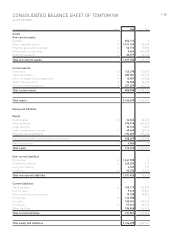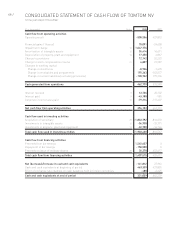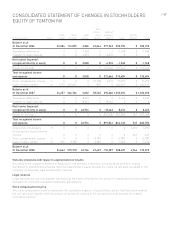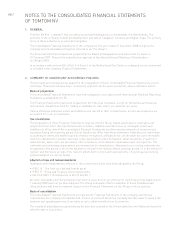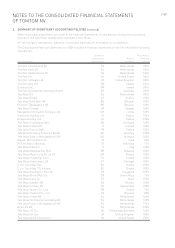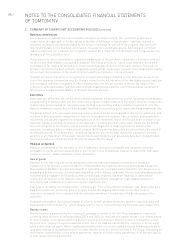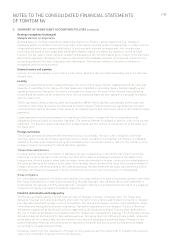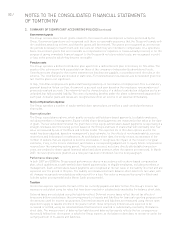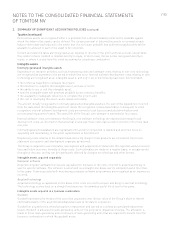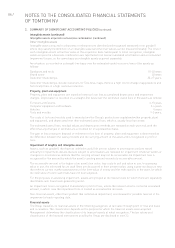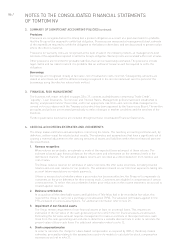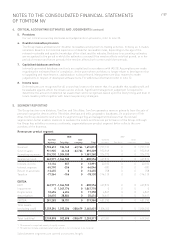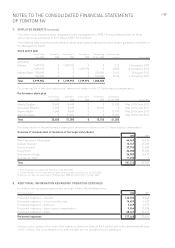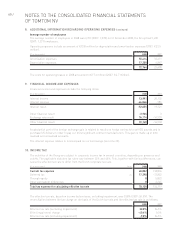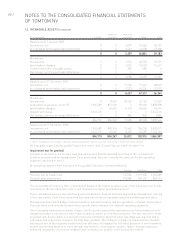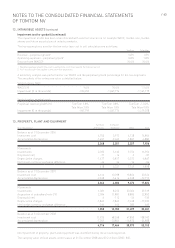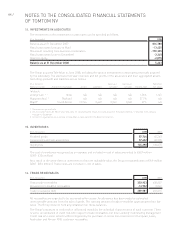TomTom 2008 Annual Report Download - page 57
Download and view the complete annual report
Please find page 57 of the 2008 TomTom annual report below. You can navigate through the pages in the report by either clicking on the pages listed below, or by using the keyword search tool below to find specific information within the annual report./ 55
NOTES TO THE CONSOLIDATED FINANCIAL STATEMENTS
OF TOMTOM NV
2. SUMMARY OF SIGNIFICANT ACCOUNTING POLICIES (continued)
Financial assets (continued)
Financial assets at fair value through profit or loss
Financial assets at fair value through profit or loss are financial assets held for trading. A financial asset is
classified in this category if acquired principally for the purpose of selling in the short-term. Derivatives are
categorised within this category if their fair value is a positive number, otherwise the derivative is classified as a
financial liability.
Loans and receivables
Loans and receivables are non-derivative financial assets with fixed or determinable payments that are not
quoted in an active market. They are included in current assets, except for maturities greater than 12 months
after the balance sheet date, which are classified as non-current assets. Loans and receivables are measured at
amortised cost using the effective interest method, less any impairment. The Group’s loans and receivables
comprise ‘trade receivables’ and ‘cash and cash equivalents’ in the balance sheet (note 16 and 19).
Fair value
The fair value of investments that are actively traded in organised financial markets is determined by reference to
quoted market bid prices at the close of business on the balance sheet date. For investments for which there is
no active market, fair value is determined using valuation techniques. Such techniques include recent arm’s
length transactions; reference to the current market value of another instrument which is substantially the same;
discounted cash flow analysis or other valuation models.
The Group holds an investment in Infotech, which has been included within the category financial assets
designated at fair value through profit and loss from the date of acquisition. Gains or losses on this investment
are recognised in the income statement.
For certain of the Group’s financial instruments, including trade receivables, trade payables and other accrued
liabilities, the carrying amounts approximate fair value due to their short maturities.
Inventories
Inventories are stated at the lower of cost and net realisable value. The cost of inventories comprises costs of
purchase, assembly and conversion to finished products. Borrowing costs are excluded. The cost of inventories is
recorded using the first-in first-out (FIFO) cost basis, net of reserves for obsolescence and any excess stock. Net
realisable value represents the estimated selling price less an estimate of the costs of completion and direct
selling costs.
Trade receivables
Trade receivables are initially recognised at fair value, and subsequently measured at amortised cost (if the time
value is material), using the effective interest method, less provision for impairment. A provision for impairment
of trade receivables is established when there is objective evidence that the Group will not be able to collect all
amounts due, according to the original terms of the receivables. Significant financial difficulties of the debtor,
probability that the debtor will enter bankruptcy or financial reorganisation, and default or delinquency in
payments (more than 30 days overdue) are considered indicators that the trade receivable is impaired. The
amount of the provision is the difference between the asset’s carrying amount and the present value of estimated
future cash flows, discounted at the original effective interest rate. The carrying amount of the asset is reduced
through the use of an allowance account and the amount of the loss is recognised in the income statement within
‘cost of sales’. When a trade receivable is uncollectable, it is written off against the allowance account for trade
receivables. Subsequent recoveries of amounts previously written off are credited against ‘cost of sales’ in the
income statement.
Cash and cash equivalents
Cash and cash equivalents are stated at face value and comprise cash on hand, deposits held on call with banks,
and other short-term highly liquid investments that are readily convertible to a known amount of cash and are
subject to an insignificant risk of changes in value.
Financial liabilities and equity instruments
Financial liabilities and equity instruments issued by the Group are classified according to the substance of the
contractual arrangements entered into, and the definitions of a financial liability and an equity instrument. An
equity instrument is any contract that evidences a residual interest in the assets of the Group after deducting all
of its liabilities. Equity instruments are recorded at the proceeds received, net of direct issue costs.


